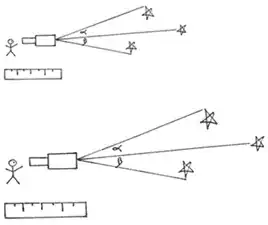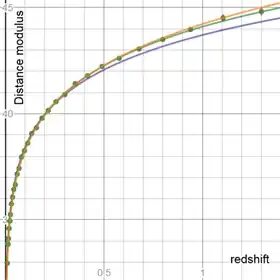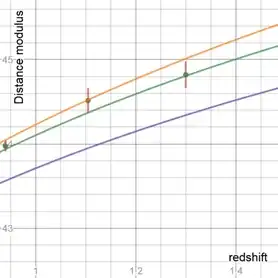From the link Is non-mainstream physics appropriate for this site?
"a question that proposes a new concept or paradigm, but asks for evaluation of that concept within the framework of current (mainstream) physics is OK."
Here is a concept, evaluation within the framework of current (mainstream) physics would be welcome.
Is it possible that an expansion of all length scales can be happening, as in the cartoon below?
It shows all lengths increasing, the size of atoms, people, stars and the distances between all objects. Each physical quantity and constant varies depending on the number of length dimensions in it. For example since Planck's constant has a length dimension of 2, so it's change with time is
$h=h_0e^{2Ht}$
where $H$ is an expansion constant and $t$ is time.
\begin{array}{c|c|c} {quantity} & {length-dimension} & {change}\\ \hline length & 1 & e^{Ht}\\ mass & 0 & constant\\ time & 0 & constant\\ h & 2 & e^{2Ht}\\ c & 1 & e^{Ht}\\ G & 3 & e^{3Ht}\\ Area & 2 & e^{2Ht}\\ \end{array}
etc...
Can this type of expansion be ruled out A) locally or B) by distant measurements e.g. of distant stars or galaxies, from within mainstream physics?
The expansion referred to occurs for the whole universe. It's proposed as there could be another reason for the redshift of light from distant stars. If the energy of a photon is conserved during flight, but was emitted when Planck's constant was lower, then from $E=hf$, the frequency of the received photon would be lower and the light from a distant star would be redshifted.
A bounty has now been added. A convincing reason why the above type of expansion cannot be occurring would be welcome.
Here is the work done so far.
It is to determine the apparent matter density that would be concluded in a flat universe, with a matter density of $1.0$ and the type of expansion above.
It leads to the conclusion that the matter density would be measured to be $0.25$ or $0.33$ from galaxy clusters and supernovae data respectively. A Diagram of supernovae data is below and then more details of the calculations.
The diagrams show the distance modulus predicited by the type of expansion in the question, top curve. Concordance cosmology with a matter density of 0.3 and 1.0 are the middle and bottom curve respectively. The second diagram is an enlargement of the first.
Matter density from Galaxy Clusters etc...
Traditionally the scale factor of the universe at redshift $z$ is
$a=\frac{1}{1+z}\tag{1}$
If the energy of the photon is conserved during flight, from $E=hf$ and $h=h_0e^{2Ht}$
For an emitted wavelength of $\lambda_1$
$z=\frac{\lambda_1e^{2Ht}-\lambda_1}{\lambda_1}$
$1+z = e^{2Ht}=a^{-2}$ ,
($a$ decreases with increasing $z$ in an expanding universe) so
$a=\frac{1}{\sqrt{1+z}}\tag{2}$
For small distance $d$
$\frac{v}{c} =z= e^{2H\frac{d}{c}}-1=\frac{2Hd}{c}$
$v=2Hd\tag{3}$
i.e. Hubble’s law is still valid but we identify the expansion parameter $H$ with half of Hubble’s constant $H_0$
this leads to the conclusion that the matter density will be measured to be $\frac{1}{4}$ of the true value, as follows.
$\Omega_m = \frac{\rho}{\rho_{crit}}\tag{4}$
$\rho_{crit}=\frac{3H(z)^2}{8\pi G}\tag{5}$
If the value for $ H(z)$ used in $\rho_{crit}$ is twice the true value, then the apparent matter density would be measured as $0.25$ instead of $1$.
Matter Density from Supernovae Data.
In LCDM the Hubble parameter is
$H(z)=H_0\sqrt{\Omega_m {(1+z)}^3+\Omega_k{(1+z)}^2+\Omega_\Lambda}$
The comoving distance is obtained from
$D_M=\int_0^z \frac{c}{H(z)} dz$
Using a flat universe approximation, omitting $\frac{c}{H_0}$ and using $m$ for $\Omega_m$ ,the comoving distance, for small $z$ is
$\int_0^z(m(1+3z+3z^2+\dots )+1-m)^{-\frac{1}{2}}dz$
$=\int_0^z(1+3mz+3mz^2)^{-\frac{1}{2}}dz =\int_0^z(1-\frac{3}{2}mz+\dots)dz$
$=z-\frac{3mz^2}{4}\tag{6}$
For the type of expansion that we hope to rule out,
The co-moving distance is
$D_M=\int_t^0 \frac{c}{a(t)} dt$
$a=\frac{1}{\sqrt{1+z}}$
$\frac{da}{dt}=\frac{da}{dz} \times \frac{dz}{dt} ={-\frac{1}{2}(1+z)^{-\frac{3}{2}}}\times\frac{dz}{dt}$
$H(z)=H=\frac{\dot{a}}{a}=\frac{-1}{2(1+z)}\times\frac{dz}{dt}$
$dt=\frac{-1}{2H(1+z)}dz$
$D_M=\int_0^z \frac{c}{2H}{(1+z)}^{-\frac{1}{2}} dz$
$D_M=\frac{2c}{H_0}(\sqrt{1+z}-1)\tag{7}$
again omitting $\frac{c}{H_0}$ and for small $z$, $(7)$ becomes
$2(1+\frac{1}{2}z-\frac{1}{8}z^2-1)$
$=z-\frac{z^2}{4}\tag{8}$
there is a match between $(6)$ and $(8)$ if $m=\frac{1}{3}$
So we conclude from Galaxy and supernovae data, or combinations of data sets, that the matter density would be measured, with the type of expansion in the question, at between $0.25$ and $0.33$. As it is measured at this value, it's concluded that the expansion cannot be ruled out this way. A diagram with supernovae data is above.
Is there a convincing reason why the expansion described should be ruled out?


